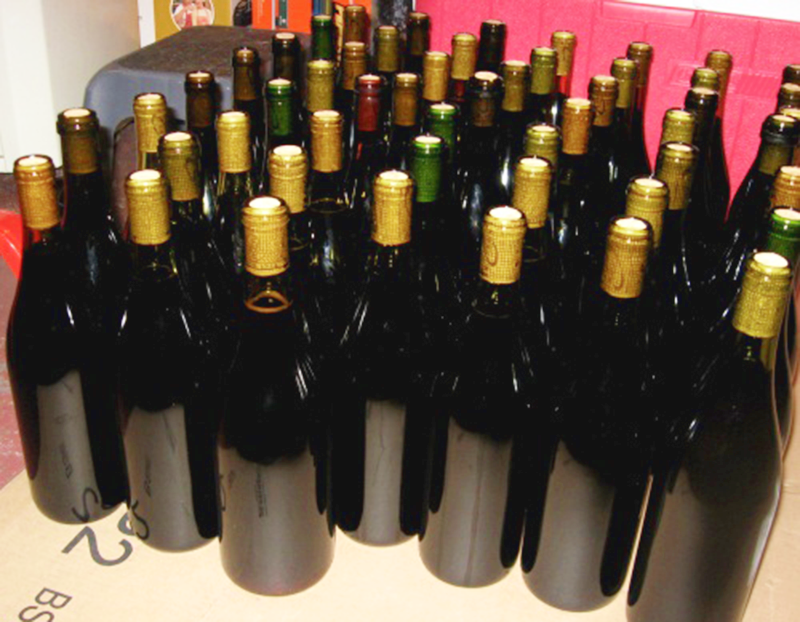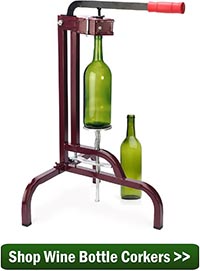 Hi everyone!
Hi everyone!
Just as a refresher, last time we caught up my Ken Ridge Classic Nebbiolo was moving along quite nicely, other than the fact that I completely forgot to add the oak granules way back in the beginning of the process.
According to the instructions that came with the Nebbiolo wine kit, the stabilization and clarification stage is only 6 days and then it’s time to bottle, however, due to my travel and unpredictable-at-times work schedule, I wasn’t able to actually bottle the wine until 13 days later. I thought this would be perfectly acceptable, since all the wine was doing at this stage was continuing to clear and if history serves me correctly, the longer I wait, the more clear the wine will be.
Since I have been having so many problems with my filter system, I decided to forgo the filtering for this particular wine and just let gravity do its thing. I do plan on revisiting this filtering system issue at some point in the near future, however, at this particular time, I was not quite ready.
So, other than the delayed bottling date and the lack of filtering, bottling the wine itself, went pretty well. I ended up getting 25 bottles (well, 24 and then ¾ of a 25th bottle) of wine out of the batch, which is probably the best yield I’ve done to date. In the past, you might remember me spilling and otherwise losing some wine, but not this time!
Other than getting sprayed a little in the eye with wine when I over-enthusiastically filled the siphoning hose prior to bottling the wine (good thing I was wearing glasses!), I didn’t lose very much at all this time. I suppose I technically lost 5 bottles since the wine ingredient kit is designed to make 30 bottles, but all in all, I’m very pleased with the yield.
 I have to say though, my least favorite part about bottle the wine probably has to be removing labels off of old wine bottles prior to cleaning/sanitizing them for use. I know, I know, I don’t HAVE to remove the wine labels, but it just looks so much cleaner and is less confusing if all my bottles have the same (or no) label to begin with.
I have to say though, my least favorite part about bottle the wine probably has to be removing labels off of old wine bottles prior to cleaning/sanitizing them for use. I know, I know, I don’t HAVE to remove the wine labels, but it just looks so much cleaner and is less confusing if all my bottles have the same (or no) label to begin with.
I put several wine bottles in a sink with piping hot water, and to my surprise all of the labels just sloughed right off without me doing anything. Unfortunately, as I put more wine bottles in, the harder it was to take the labels off and the more I had to scrap off the teeny tiny bits of glue with a knife. I don’t know if this is because the water was cooling down making the glue less likely to “let go” on its own, or if the labels are just all so different that some are easy to take off while others make you want to throw the bottle out the window.
I realize this complaint is extremely minor in the grand scheme of home winemaking, but I feel better now that I got it off my chest. Cheers!
———————————–
 My name is Leigh Erwin, and I am a brand-spankin’ new home winemaker! E. C. Kraus has asked me to share with you my journey from a first-time dabbler to an accomplished home winemaker. From time to time I’ll be checking in with this blog and reporting my experience with you: the good, bad – and the ugly.
My name is Leigh Erwin, and I am a brand-spankin’ new home winemaker! E. C. Kraus has asked me to share with you my journey from a first-time dabbler to an accomplished home winemaker. From time to time I’ll be checking in with this blog and reporting my experience with you: the good, bad – and the ugly.

I will attest that all labels are different.. some come right off, others give you quite the struggle. Gas works well to remove the glue, but of course.. use with caution!
I would be nice for a more fool proof way to easily remove old labels that does not include gasoline…
Brad,
For those that do not come off with water I use a little cleaning solvent or paint thinner on a rag. Neither of these are as flammable as gasoline. After washing I put the bottles on a Bottle Tree. When I go to use them is when I sanitize them.
Leigh,
To remove labels, I do the same thing as you by placing them in hot water, but I do them usually one or a few at a time – often a day or so after I’m done drinking a bottle. My own labels don’t come off too easily. I do the artwork and print them to 3 1/3″ x 4″ shipping labels (I size them so I can cut the rounded corners out using a straight edge and utility knife, making square corners).
To remove the tougher labels, I use a glass scraper (razor-type blade) after soaking. I also use Goo Gone to get the remnants and residual glue. Then I use soap and water to clean the exterior. I store the bottles upside down in a wine box (paper towels at the bottom to catch any water from inside the bottle). When it’s time to bottle, I then clean and sanitize as usual.
I find the one or more at a time is less painful and usually use a smaller container or a bucket so I’m not using a whole sink full of water.
The delayed bottling is no big deal, by the way. I usually let my wine (reds, in particular) age for a few months in the carboy before bottling. I check the water in the air lock every day at some point, use a solid bung to seal the carboy.
Hope this helps. Feel free to respond and let me know how it goes.
Larry
Try to find a local wine or beer supply store where you can buy new bottles of various types for about $12.00 a case of 12. Shipping the heavy bottles is what adds considerably to the cost.
I have also used a razor blade scraper to remove labels from used bottles, it’s not an easy task. As you have already found out ,the type of adhesive used is quite different. Some will come off with just soaking, while others require a lot of scraping, Good luck in your wine making adventure.
Armand
Leigh: For removing labels in addition to the hot water, a stainless steel scouring pad with just a very little dab of dish soap on the pad works very well. Grab the bottle by the neck and use the scouring pad to remove the remaining label and adhesives then rinse the bottle off and set it aside before sanitizing – doing it this way keeps any soap from getting into the bottle.
I have found no easy way to remove labels from the bottles I am always looking for suggestions.
I have been filtering my wines using the pressure filter that I believe you are using.
I haven’t had much trouble since the first wine I used the filter on.
Other than making sure the two filter pads are installed correctly, I make sure the nuts and bolts are secured really tight.
I added two pinch valves on the discharge lines that help a lot in making sure the last of the wine is sent through the bottom filter.
The plum wine I filtered recently did not ooze a tablespoon through the seals.
The final clarity of the wine is a very big plus for me.
Suggest you scratch the labels, put the bottles in hot water and the hot water may get to the labels glue easier. Another method would be to scratch the labels, put wallpaper adhesive desolver on the label..